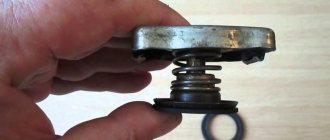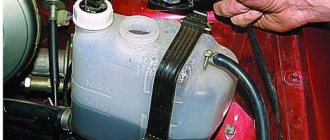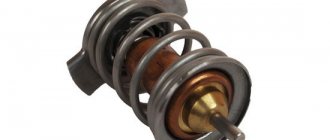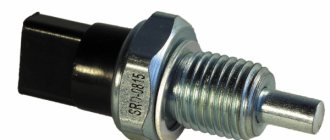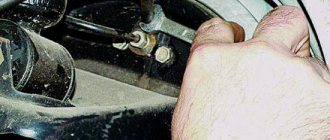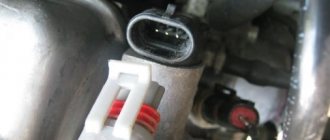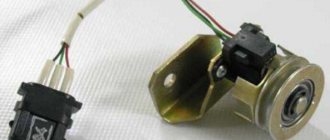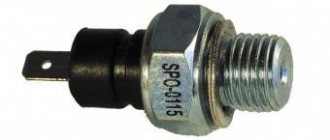The coolant temperature sensor (DTOZH) is part of the engine control system (ECM) of injection vehicles VAZ 2108, 2109, 21099. Based on its readings, the control unit (ECU) determines the thermal state of the engine and calculates the required amount of fuel mixture for injection and ensuring normal operation.
Temperature sensor location
On VAZ 2108, 2109, 21099 cars with injection engines, the sensor is installed in the coolant outlet pipe between the thermostat and the block head.
DTOZH device
It is a thermistor - a resistor with a negative temperature coefficient, the resistance of which changes with increasing or decreasing temperature. When heated, the resistance decreases, when cooled it increases. For example, at plus 100 gr. – resistance 180 Ohms, at minus 40 – resistance 100700 Ohms. On one side of the sensor there are two contacts; on the other (located in the coolant flow) there is a sensitive element.
Operating principle of DTOZH VAZ 2108i, 2109i, 21099i
After turning the key in the ignition switch, the control unit supplies voltage to the DTOZH through a resistor with a constant resistance located inside the unit. Since the temperature sensor is a thermistor, the voltage supplied from the ECU will immediately change depending on the coolant temperature. Based on the voltage drop, the control unit calculates the engine temperature and, accordingly, the volume of fuel for injection. The voltage drop will be high when the engine is cold (more fuel) and low when the engine is warm (less fuel). As the engine warms up, the volume of fuel entering the engine cylinders decreases.
In addition to starting, based on the temperature sensor readings, the control unit adjusts engine idle speed, decides to enrich the fuel mixture at medium and high load modes, changes the ignition timing in one direction or another, and turns the cooling system fan on and off.
DTOZH malfunctions
If the temperature sensor goes out of order, it does not allow the ECU to correctly calculate the dose of fuel required by the engine at the moment, and this in turn leads to the inability to start the engine, especially in cold weather, interruptions in its operation at idle and while driving, and increased fuel consumption. In addition, a malfunction of the DTOZH may be one of the reasons for engine overheating (untimely switching on of the cooling system fan) or, conversely, its prolonged warming up.
In some cases, if a temperature sensor malfunctions, the engine control system switches to backup mode. In this case, at startup, the ECU considers the engine temperature to be zero, the calculation of the dependence of the volume of injected fuel on engine warming up will be carried out based on the time it is running, and not on the readings of the temperature sensor, the cooling system fan will be constantly on. The light on the instrument panel lights up and the self-diagnosis system writes an error code into the memory of the control unit.
You should not immediately replace the sensor with a new one; you must first check the sensor connection connector and the wires leading to it. If a malfunction occurs on the way, you can remove the connector from the sensor and drive to the repair site in the ECM backup mode.
Applicability of DTOZH
VAZ 2108, 2109, 21099 – DTOZH 2112-3851010 (23.3828).
Notes and additions
— A resistor is an element of an electrical circuit that has resistance. They allow you to control and regulate the voltage and strength of the electric current passing through them. The unit of resistance is Ohm.
If you notice that the coolant temperature gauge of the VAZ 2109 shows an incorrect value, then there is a need to check it. The coolant temperature sensor is designed to monitor engine temperature. Of course, this sensor does not affect the operation of the cooling system of the VAZ 2109. The operation of the cooling system is influenced by the thermostat and the sensor on the radiator, which turns on the radiator cooling fan when the coolant temperature is more than 90 degrees. The coolant temperature sensor is intended only for INDICATORING the engine temperature on the instrument panel of the VAZ 2109. However, this is also important; you, as a driver, must know the temperature of your engine.
The VAZ 2109 coolant temperature sensor is a thermal resistance, that is, an electrical element that changes its resistance depending on the temperature. The VAZ 2109 operating manual says that to check the coolant temperature sensor, it must be removed, then placed in a glass of water of a known temperature and its resistance measured. As always, the developers took the most difficult route: to get the sensor out of the engine, you need to drain the antifreeze to the level of the sensor (and this is not very easy to do, considering that you will have to remove some hose to drain it), go somewhere to heat the water and check it later go back to the car, screw the sensor into place and fill it with antifreeze again.
You can do it much simpler: take three resistors - one 600 Ohm, the second 160 Ohm, the third 100 Ohm. These resistors will simulate a temperature sensor. Open the hood, remove the chip from the temperature sensor and bring it to the battery. We insert a 600 Ohm resistor at one end into the battery ground, and attach a sensor chip to the other end.
We go into the salon and turn on the ignition - the temperature gauge needle should show about 50 degrees.
Then, instead of the 600 Ohm resistor, we insert a 160 Ohm resistor - the temperature indicator arrow should show 90 degrees.
On the third 100 Ohm resistor, the temperature gauge needle should show more than 100 degrees. If, when connecting resistors and changing them, the temperature indicator shows the above values (they may differ slightly), then the wire from the sensor to the indicator and the indicator itself are working. Please note that if you drive a car for more than 10 minutes, that is, on a probably warmed-up engine, but the gauge does not show the temperature, then your temperature sensor is really faulty and needs to be replaced, it is inexpensive, about 2-3 $ and is sold in any auto shop. If you connect resistors between ground and the sensor connector, and when the ignition is turned on, the arrow stands dead in place, then the problem is not with the sensor. It is necessary to check the wire from the sensor to the indicator and the temperature indicator itself.
In any car, the cooling system plays one of the main roles. Every motorist should know how to check. Temperature sensors are installed on all injection and carburetor machines, but their functions are slightly different.
For example, on carburetor engines, the temperature sensor only allows you to display information about the current parameter value on the dashboard. But in injection systems, one sensor allows not only to display the current system temperature on the instrument panel, but also sends a signal to the computer, which turns on the cooling fan.
What is a coolant temperature sensor
All sensors are used to monitor the operation of certain components and parts. If the operation functions are disrupted, the sensor indicates that the operation of a particular device is unstable. A car has many sensors in its design.
Important recommendation: is it possible to mix antifreeze with antifreeze or with each other, or with water, and what will happen if you mix it? The answer can be found in the link.
The internal combustion engine needs stable operation. So, the cooling fluid temperature sensor provides control over the stability of the internal combustion engine. The car’s engine heats up faster thanks to this sensor and is slower to reach high temperatures that lead to boiling of the coolant in the system.
DTOZH is not a sensor that shows the temperature of the fluid in the block and radiator system. Some people have the wrong idea about this.
The coolant temperature sensor transmits fluid temperature data (antifreeze, antifreeze or water) to the electronic control unit (ECU). And the temperature of the liquid that the driver sees on the dashboard is transmitted by another sensor, also a temperature one.
If the sensor that displays the temperature value for the driver breaks down, then this will not bring anything serious to the system. And, if the sensor that transmits the temperature value to the computer fails, then the control unit will incorrectly regulate the operation of the internal combustion engine.
Information for novice motorists: the cooling system (radiator, engine cooling system jacket) must contain a liquid (preferably one that has a high boiling point) that removes heat from the engine.
In addition to removing heat and cooling the engine, the circulating coolant cools the engine oil, which, when boiling, loses its properties.
The coolant also cools the air that is in the turbocharging system (turbine), cools the exhaust gases and the gearbox oil. The sensor has the function of heating air in ventilation and heating systems.
The coolant temperature sensor is a small link in the aggregate design of the car system, but it is very important. The stability of the motor depends on its correct operation and serviceability in general.
Symptoms of malfunction
To ensure that the correct data from the coolant temperature sensor is transmitted to the electronic control unit, it must be properly installed.
Unscrew
The DTOZH location is located near the thermostat housing. The sensor tips must be in contact with the coolant.
Therefore, the root cause of the incorrect operation of the DTOZh may be its banal incorrect installation.
Some symptoms will allow even an inexperienced motorist to determine that the problem lies in this sensor:
- Exhaust gases are of very low quality due to a disturbed air-fuel mixture;
- Fuel consumption figures have increased noticeably;
- Exhaust gases have a deteriorated composition;
- The engine becomes difficult to control;
- A malfunction code is displayed on the dashboard, or a warning light begins to blink, indicating overheating of the power unit;
- It is difficult to start the engine.
Many people immediately drive the car into the garage and begin replacing the coolant temperature sensor on their VAZ 2110. But often the cause of such symptoms is the presence of damaged wiring or poor contact of connections. Therefore, check them first.
It is also possible to determine externally that the sensor has failed. The presence of traces of rust, corrosion on the device, and deposits indicate that it is better not to use this sensor in the future.
You can arm yourself with a voltmeter or multimeter to determine the resistance. When cold, normal sensor readings should be 2V, and if the engine is hot, then 0.5V. Any deviations from the norm indicate failure of the meter.
Design and principle of operation of DTOZH
When the sensor contacts close, the system receives information that the temperature of the liquid has risen.
Due to the similarity of functions, a temperature sensor is similar to a resistor. The sensor is designed in such a way that the resistance of the electric current changes as the temperature around it changes. Changes in resistance are transmitted to the electronic engine control unit.
Before DTOZH, so-called thermal relays were used. They were installed in injection systems. When the contacts were in the open position, the internal combustion engine heated up. If the contact closes, then the motor has reached operating temperature (usually 90 degrees).
The thermistor is the main design element of a temperature sensor. It is the thermistor that determines how the current resistance will depend on the ambient temperature.
In turn, the thermistor consists of cobalt, or rather oxides of cobalt (Co) and nickel (Ni). When heated, these substances increase in number of free electrons. Due to the increase in free electrons, the resistance decreases.
There are thermistors with negative temperature coefficient. In this case, the thermistor shows maximum values when the engine is cold. A voltage of 5 Volts (V) is supplied to the temperature sensor. Further, when the engine heats up, the sensor will reduce resistance.
The ECU looks at voltage changes and, based on this data, calculates what the fluid temperature is at the moment. When the engine is hot, the electronic control unit gives the command to supply a lean mixture of fuel and air.
If the sensor is faulty, the ECU may give a command to enrich the fuel mixture when it should have been made lean. When working with a rich mixture, the spark plugs will quickly become dirty.
The engine may not start if the engine speed at startup is not sufficient. The ECU can give a command to increase the speed. In order to maintain controllability while starting the internal combustion engine, the recirculation valve must be in the closed position until the engine reaches operating temperature.
If the speed fluctuates, then this is one of the signs that the temperature sensor is not working correctly. In this case, the engine may stall. The ignition angle depends on the correct operation of the sensor, because this parameter is also regulated through the ECU. The emission of harmful substances from spent fuel mixtures with such regulation is reduced.
As a result, it turns out that the power and operational characteristics of the car depend directly on the operation of the coolant temperature sensor.
Where is DTOZH located?
In different brands and models of cars, the temperature sensor is located in different places. But, usually it is installed in the cylinder head (cylinder head), not far from the thermostat or directly on it. It is also imperative that the sensor is located near the outlet pipe through which antifreeze or antifreeze, or water flows back into the radiator. This is the optimal location. In this case, the sensor transmits accurate information to the ECU.
Types of sensors
Classification of DTOZH by change in resistance:
- Negative temperature coefficient sensor. The operating principle is that the internal resistance drops as the temperature increases.
- Sensor with positive temperature coefficient. The operating principle is the opposite of that of the first type of sensor, that is, the internal resistance increases with increasing temperature.
The most popular in the automotive industry is the first type of DTOZH. It happens that there are 2 sensors installed in the car, the main one and the additional one.
The main sensor transmits information to the electronic control unit, and the additional sensor turns on the fan.
Types of sensor malfunctions and how to fix them
Due to the simple design of the sensor, it is considered reliable. The simpler the design, the higher the reliability. The sensor may have a calibration problem. In this case, the resistance value will change at random and incorrect information will be transmitted to the ECU.
The main and main breakdown or malfunction of the coolant temperature sensor is that it does not turn on the fan when the switch-on temperature is reached.
The malfunction may be caused by oxidation of the wiring plug or a breakdown of the additional sensor responsible for the operation of the fan.
DTOZH malfunctions:
- engine speed drops for no reason;
- The motor takes a long time to heat up;
- the engine often overheats;
- increased fuel consumption;
- deterioration in vehicle control;
- Black smoke comes out of the muffler;
- there is no stability in the operation of the internal combustion engine.
There are also knocking sounds in the engine - detonation. On older cars a controller was installed. When the controller arrow reaches beyond the critical zone, an immediate stop of the vehicle is required. This may be due to a breakdown of the DTOZH.
And in modern cars, the on-board computer will tell you that the engine has overheated and needs to stop. By the way, if antifreeze, antifreeze or water boils, you cannot turn off the engine. You need to stop and let it idle. When the temperature drops a little, turn off the engine.
Major sensor failures
You need to know how to check the coolant temperature sensor with a minimal set of tools on hand. All you need is a multimeter. Among the main sensor failures are the following:
- The calibration of the thermistor is violated, because of this the resistance of the element does not correspond to the temperature values that are set for the sensor.
- The positive terminal of the device is shorted to ground.
- The seal of the element is broken.
- There is no electrical contact in the connector, the wiring is broken.
How to check if the temperature sensor is working
To dismantle, check, replace the sensor, the following tools are needed:
- 19mm wrench.
- Multimeter.
- Container for draining coolant.
- Electric kettle for heating water.
- Thermometer.
- Another container, but for hot water, small, for example, a glass.
How to check
Diagnostics are done using special equipment in car services. To check whether the sensor shows the temperature correctly, you need to lower it into hot liquid and measure the resistance with an Ohmmeter or multimeter in the resistance position. On different sensors, different brands and models, resistance values may vary. On the Internet there are special tables with resistance data for which sensors of a particular model.
If the resistance value differs from what it should be according to the table, then the temperature sensor must be replaced. The sensor cannot be repaired.
How to check the coolant temperature sensor?
- Take the sensor and lower it into warm water.
- Take a thermometer and lower it into a container of cold water. For accurate readings, it is better to use an electronic thermometer.
- We connect a multimeter to the sensor and lower the sensor into the water. Let's see what the measuring device shows.
- Cold water at this time heats up to 15, 20, 25 degrees. The results are recorded. At what temperature, how much does the resistance show. If the data does not coincide with the tabular, reference data, then the sensor must be replaced.
There is another way to check the temperature sensor without a thermometer. Water usually boils at 100 degrees. We measure the resistance when the sensor was immersed in boiling water. The resistance in this case should be approximately 176 ohms. Plus or minus the error can reach up to 190 Ohms. But without a thermometer, this is a rough check.
Now I will give a table showing at what temperature and within what limits the resistance should be.
| Temperature, C | Resistance, Ohm |
| 0 | 5 000 — 6 500 |
| 10 | 3 350 — 4 400 |
| 20 | 2 250 — 3 000 |
| 30 | 1 500 — 2 100 |
| 40 | 950 — 1400 |
| 50 | 700 — 950 |
| 60 | 540 — 675 |
| 70 | 400 — 500 |
| 80 | 275 — 375 |
| 90 | 200 — 290 |
| 100 | 150 — 225 |
Replacement
The check showed that the sensor was to blame. Therefore, you have no choice but to replace it with a new one. For this:
- The coolant is drained. It is better to drain the maximum amount. Especially if the coolant has long been due for replacement;
- Disconnect the terminals from the battery;
- To make it more convenient to work, remove the air filter from its seat;
- Turn off the ignition and remove the sensor connector;
- Use a 19mm wrench to remove the sensor. The sealing ring must be removed along with it;
- A new seal ring is taken and a new, high-quality coolant sensor, suitable for the VAZ 2110 model, is mounted in place of the old one;
- The entire assembly process is performed in reverse order.
The coolant temperature sensor for the VAZ 2110 plays an important role. The owners of this model know very well that its failure is not a rare situation. The good news is that the replacement procedure is not complicated and can be carried out by any driver, even whose driving experience does not exceed several days.
As for the cost of self-repair, you only need to purchase a new O-ring and the sensor itself, of course. Today, a good quality device for a “ten” costs about 200 rubles. The tools are only the most standard ones, so you won’t have to buy anything or spend any extra money.
A professional will do the work at the auto repair shop, but the cost of the repair will be appropriate. Plus, many service stations use cunning moves, trying to force the car owner to perform a number of additional measures. Sometimes they are really useful, but sometimes they are just an attempt to get more money out of you.
Decide for yourself whether it’s worth taking the car to a service center to replace the TOZ sensor, or whether you can calmly complete the entire procedure yourself in an hour, but save a decent amount of money.
How to replace a temperature sensor
This can be done with your own hands; it does not require much experience. The order is:
- Drain the coolant.
- Remove the old sensor. It screws into the special. threaded hole. We unscrew it.
- Screw in the new sensor. It is recommended to lubricate the seat with sealant before screwing it in.
Conclusion
So, the coolant temperature sensor is one of the important elements in the design of the car. If it malfunctions or completely fails, the operation of the internal combustion engine is immediately felt. Deviations in work, as they say, are obvious.
The sensor is a thermistor. It transmits data on changes in temperature outside to the ECU through changes in resistance.
Video
This video explains how to properly replace the sensor.
Checking the sensor yourself at home.
The VAZ temperature sensor does not work.
0
Author of the publication
offline 1 day
Engine temperature display: note to Nines owners
Each car engine is equipped with a device for measuring the temperature of the power unit. This component allows the driver to detect overheating in time and eliminate this problem. What is the fan switch on sensor on a VAZ 2109 with a carburetor engine, what is its structure and how to replace it - read on.
Location of the coolant sensor in the VAZ 2109
First, it is advisable to know where the engine temperature sensor is located. On models 2108, 21099 and VAZ 2109, the coolant temperature sensor is installed between the cylinder head and the thermostat, in the exhaust pipe.
Device and principle of operation
The engine temperature controller itself is a thermistor-resistor device characterized by a negative temperature coefficient. The resistance parameter itself can be measured only when the temperature decreases or increases.
When the power unit heats up as a result of operation, the resistance indicator decreases; if the engine cools down, this parameter increases. For example, at the operating temperature of the engine on a VAZ 2109, the resistance is equal to 180 Ohms, and if it is 40 degrees cold outside, then the resistance will be equal to 100,700 Ohms. On one side of the DTOZH VAZ 2109 injector there are two contacts, and on the other there is a sensitive component, which is located directly in the flow of consumables.
As for the principle of operation, when the driver turns on the ignition, the control unit transmits voltage to the regulator via a resistor. Since the DTOZH itself is a thermistor, the voltage supplied from the control unit changes immediately taking into account the temperature of the consumable. When the parameter decreases, the unit analyzes the temperature and, in accordance with these data, determines the required volume of gasoline for injection. As the power unit warms up, the volume of gasoline that is transferred to the cylinders will decrease.
Two antifreeze temperature sensors for VAZ
In addition to starting, according to the readings of the regulator, the ECU adjusts the operation of the power unit at idle speed. As a result, he independently makes decisions on enriching the combustible mixture at high and medium loads on the internal combustion engine. This indicator can be changed depending on the ignition timing.
There are two temperature sensors on a carburetor car. One turns on the fan, the other is responsible for indicating the temperature on the dashboard.
Possible faults
There are several reasons why the regulator on the VAZ 21099 refuses to work.
So, why DTOZH does not work:
- An electrical contact is located inside the device structure. Over time, this contact may simply break or cracks may form on it. If a break occurs inside the structure, this may cause complete failure. That is, the DTOZH will simply burn out. If there are cracks on the contact, the DTOZH, in principle, can work, but as a result of the lack of normal contact, the regulator will transmit incorrect data about antifreeze.
- Poor device insulation. If the insulation is broken, short circuits may occur in the operation of the device. Accordingly, ultimately, these short circuits can lead to the DTOZH, again, burning out and having to be replaced.
- There was a broken wire near the regulator. As a result of the break, the regulator will not be able to activate the fan designed to cool the power unit. Accordingly, this will lead to the engine overheating and may even boil (the author of the video is a Mechanical Technician).
How can a car owner understand that the DTOZh is out of order and it’s time to replace it?
To do this, it is enough to know about the main signs of problems, which we will discuss below:
- The fan designed to cool the engine can turn on randomly at any time. In particular, the driver should be wary that the fan turns on when the engine is not completely warmed up. Remember that the fan should always function when the internal combustion engine is overheated.
- The driver has difficulty starting a warmed-up internal combustion engine. The cooling system should automatically adjust the temperature, but because the unit is faulty, it cannot receive the correct signal.
- If you carefully monitor the operation of the car, you will notice that gasoline consumption has increased. The increase in consumption is due to the fact that the car is simply overloaded when running on a hot internal combustion engine.
- If the device fails completely, the gauge on the dashboard will show an incorrect temperature signal. A ten-minute drive is enough to warm up the engine. If after 10 minutes the temperature has not risen to the optimal temperature or when starting the internal combustion engine, the dashboard shows overheating, this indicates a malfunction.
Checking and replacing DTOZH
There are several options for diagnosing the device - the first one:
- The negative probe from the voltmeter must be connected to the engine and turn on the ignition.
- Using a tester, it is necessary to determine what voltage parameter is generated during movement.
- If the DTOZH is working, then the voltage should be at least 12 volts when the battery is fully charged. If the obtained indicators are lower, it is necessary to replace or repair the device.
Temperature and resistance table
The second diagnostic method:
- You will need to set the multimeter to voltmeter mode - measurements are carried out in the range from 100 Ohms to 10 kOhms. Also prepare a thermometer that can measure temperatures greater than one hundred degrees. The regulator should be removed and placed in a container with antifreeze.
- You need to warm up the coolant. As a result of an increase in temperature indicators, you need to monitor the readings given by the thermometer.
- Using a multimeter, you should measure the resistance of the DTOZH at different temperature conditions. The obtained parameters should be compared with those indicated in the table above.
How to make the replacement yourself:
1. Disconnect the wires that are connected to the DTOZH. 2. Unscrew the regulator with a wrench. 3. Remove the device and replace it with a new one.
- First of all, all the coolant must be drained from the radiator. Then disconnect the negative terminal from the battery, simply unscrew the nut with a wrench and disconnect it.
- Next, you need to disconnect the block with wires that connects to the DTOZH.
- Use a wrench to completely unscrew the device. Next, the regulator is removed from its seat; as mentioned above, this is the cylinder head exhaust hose. There is a rubber seal on the device itself; it cannot be lost when dismantling the DTOZH, especially if you have a new sensor without a seal.
- Then install the new regulator in its seat, in the outlet hose. Using a wrench, tighten the adjuster all the way. After installation and tightening, the previously disconnected wiring harness should be connected to the DTOZH. The final step in this process is to pour the antifreeze back into the radiator and reinstall the disconnected negative battery terminal.
Video “Visual instructions for replacing the device”
You can learn how to replace the sensor yourself at home from the video below (the author of the video is Thoughts and advice from Mustafa Murtazaev).
AvtoZam.com
